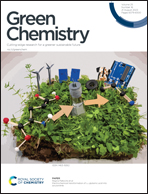Designing dual-atom cobalt catalysts anchored on amino-functionalized MOFs for efficient CO2 photoreduction†
Abstract
Unlocking the potential of sustainable fuel production through the development of highly efficient CO2 reduction catalysts under visible light irradiation remains an ongoing challenge. Herein, we report a strategically designed Zr-based metal–organic framework (MOF) photocatalyst, incorporating binuclear cobalt complexes as catalytic sites for effective CO2 reduction. Impressively, our Co2-MOF(–NH2) catalyst showcased a CO yield of 2.44 mmol gCo−1 h−1, outperforming its mononuclear counterpart Co-MOF(–NH2) (0.23 mmol gCo−1 h−1) by 10.5 times, underscoring the exceptional catalytic capabilities of the dual-atom catalyst. A combination of experimental findings and Density Functional Theory (DFT) calculations unveiled the synergistic catalytic effect between the two Co sites and the heightened light absorption attributed to the incorporation of the amino group. Notably, such characteristics are evocative of cooperative catalysis observed in biological enzyme systems. This study highlights a pioneering, bioinspired approach to designing efficient dual-atom MOF photocatalysts for CO2 reduction, offering significant implications for the future of sustainable energy production.



 Please wait while we load your content...
Please wait while we load your content...